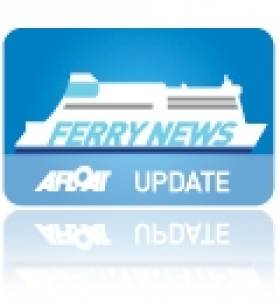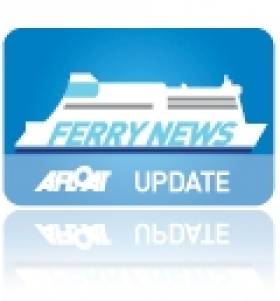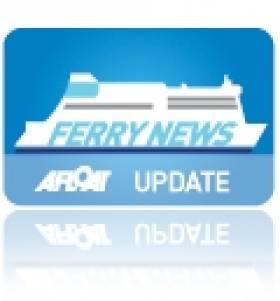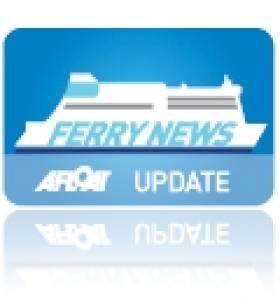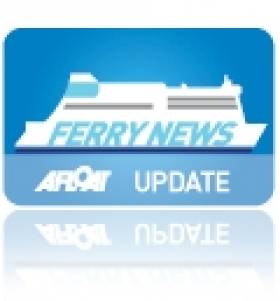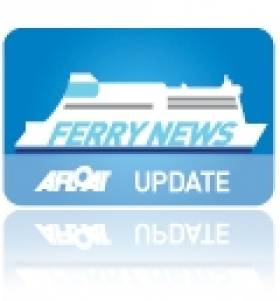Displaying items by tag: Stena Line
Stena's Diverse Fleet Shows Similarities on Irish Sea
#StenaSimilarities- Stena Line which operates services throughout Northern Europe including the Gothenburg-Frederikshavn route has seen the return to service of Stena Jutlandica, the ro-pax having undergone maintenance, writes Jehan Ashmore.
Last Saturday Stena Jutlandica (1996/29,691grt) resumed the 3 hour 15 minute Kattegat route between Sweden and Denmark. She strongly resembles Irish Ferries Isle of Inishmore (1997/34,031grt) which serves on the slightly longer 4 hour St. Georges Channel Rosslare-Pembroke route.
The reason for the design similarities is that Stena Jutlandica and Isle of Inishmore were both launched from Van der Geissen-de Noord, Rotterdam. The Dutch yard no longer exists.
During the four-day absence of 'Jutlandica', there was no replacement of the ferry, though route fleetmates Stena Danica (conventional ferry) and Stena Scanrail (train-ferry) provided additional sailings.
A fourth route ferry the Stena Carisma was only withdrawn from service earlier this year. The Westamarin built HSS 900 fast craft from Norway is a smaller version of the trio of Finnyards built HSS 1500 fast-craft.
The first of the revolutionary trio, Stena Explorer is unique in that she is the only HSS member left and of any fast-craft design ferry in the extensive company's fleet.
As previously reported, Stena Explorer is to resume Christmas period sailings on selected dates in December on the Dun Laoghaire-Holyhead route. In addition she is to operate some sailings in the New Year during early January.
Her former Irish Sea running mate, Stena Voyager became redundant on the North Channel's Belfast-Stranrear before a switch of Scottish terminal. Last year she was towed to Sweden where a subsidiary of the ferry company, Stena Recycling undertook dismantling the fast-craft ferry.
The third of the trio, Stena Discovery served on the longest route operated by a HSS craft, that been Harwich-Hook van Holland. She was sold to Venezuelan interests and the craft is understood to have never entered service.
Stena Line Deployment of ‘Superfast X’ Remains Tight Lipped
#StenaSuperfastX – Furthermore to a previous report over rumours that Stena Line are to deploy the Stena Superfast X onto the Dublin-Holyhead route in early 2015, following conversion work contracted to MacGregor, Afloat.ie has contacted the ferry company to comment, writes Jehan Ashmore.
MacGregor, part of Cargotec Corporation announced that they received a contract from Stena to convert the 29,800gt ropax ferry (currently named Dieppe Seaways) to optimise it for its new route between Dublin and Holyhead.
In response Peter Arvidsson Director Network & Fleet at Stena Line said "Although it is correct that MacGregor has been appointed by Stena RoRo to return the vessel to its original configuration, where the vessel will be deployed is currently a matter for ongoing discussion. From Stena Line's perspective it is possible that the Superfast X will be used within the Stena Line network or she may be chartered to a third party operator, but no decision has yet been taken".
It is understood that work is to begin once the charter of Dieppe Seaways running for DFDS Seaways Dover-Calais service ceases this month.
MacGregor's is to return the ro-pax ferry to its original configuration as dictated by expected requirements. This will involve the delivery of ro-ro cargo access equipment, including the design and installation of bow doors, a bow ramp, a new watertight door and a stern ramp.
Should the 'Superfast X' be introduced on the important Dublin-Holyhead route, she would provide an increase in passenger and freight capacity on the central corridor link. In addition she would be a closer match to the route's ro-pax Stena Adventurer, though not her running mate, the smaller Stena Nordica.
Stena Line's other Dublin Bay service from Dun Laoghaire to Holyhead has operated its fourth consecutive summer-only season which ended in early September. The route is served by the fuel thirsty and expensive to operate HSS Stena Explorer.
In efforts to stave off steep rise in fuel costs in recent years on the loss making route, Stena Line have reduced HSS sailings to a single daily round trip and increased crossings times from 99 minutes to 2 hours 20 minutes.
In response to Afloat.ie on the future of Dun Laoghaire-Holyhead route? Stena Line commented that the HSS is scheduled to return for the Christmas period (as previously reported) and is also scheduled for seasonal service 2015.
Stena Line to Take On Another ‘Superfast’
#StenaSuperfastX – According to Ships Monthly, Stena Line remain tight-lipped about the deployment of 29,800 tonnes ferry which is to join their fleet early in 2015.
Although an appearance on the Irish Sea service between Holyhead and Dublin has been rumoured for several months, neither Stena's head office in Gothenburg, nor Irish Sea management had made any announcement before the end of September.
MacGregor, part of Cargotec, say they have been contracted to provide a complete turnkey delivery of ro-ro cargo access equipment for the vessel, including the design and installation of bow doors, a bow ramp, a new watertight door and a stern ramp, and seem to be in no doubt that Stena Superfast X will be making an Irish Sea debut from Holyhead next January.
For more on this story click HERE.
Afloat.ie adds that should Stena Superfast X be introduced on the core Dublin-Holyhead central corridor route, she would be the third sister from an original quartet (built for Greek operator Superfast Ferries) to operate for Stena Line on the Irish Sea.
The existing Irish Sea 'Superfast' pair are Stena Superfast VII and VIII which operate Belfast-Cairnryan services having been introduced three years ago this month on a North Channel route. The route from Belfast to the Scottish port was switched from Stranrear to a new £80m port at Cairnryan.
Stena HSS to Resume Sailings for Festive Season
#HSSresumes – Stena Line sailings will resume on the Dun Laoghaire-Holyhead route for the Christmas Season and early New Year period. The HSS fast-craft Stena Explorer returns to service having ceased summer sailings in early September.
Stena Explorer will sail over the Christmas period on the following dates, December 20th, 21st, 22nd, 23rd, 24th, 27th, 28th, 29th, 30th and in January on the 2nd, 3rd, 4th and 5th.
Crossing times on the Ireland-Wales route takes 2 hours and 20 minutes. A single round trip is made on each of the selected sailings dates. For further information, including the sailing schedule, visit the Stena Line website HERE.
Stena Line Ferry With 18 Passengers Adrift in Belfast Lough
#FerryAdrift – According to the Belfast Telegraph, a Stena Line ferry, Stena Superfast VIII drifted from its berth in Belfast Lough yesterday with 18 passengers and 55 crew on board.
The ferry is one of a pair of Stena Line's Superfast twins that operate the frequent Belfast-Cairnryan route.
Passengers disembarked at the Stena Line terminal. A company spokesman said the incident was caused by stormy weather.
"Severe weather conditions in Belfast Port caused the Stena Superfast VIII to drift from her berth at VT4.Tugs from the port were deployed to help manoeuvre the ship back on to berth.
For more including footage of passengers interviewed about the incident, click HERE.
Sulphur Regulations to Force Changes at Stena Line
#EUsulphurDirective - The EU's new sulphur directive for shipping traffic within the North European Sulphur Emission Control Areas (SECA), which comes into force on 1 January 2015, is due to have a significant economic impact on Stena Line's business.The Swedish owned ferry company is to face more than £100,000 per day in extra fuel costs.
The new sulphur directive has been in the planning stage for a number of years and its negative economic impact, a significant increase in fuel costs, was one of the key drivers behind Stena Line's decision to implement a company-wide two year Change Programme in 2013.
One of the key objectives of the Change Programme was to improve Stena Line's performance by £100m to help put the company on a more secure financial footing post- directive implementation. The rolling programme has resulted in a number of steps being taken including the reduction from two vessels to one on the Trelleborg-Sassnitz route and the fact that Stena Line is now being forced to increase its prices to freight customers as a direct result of the change in legislation.
"From an economic perspective, this is one of the largest negative political decisions taken since tax-free shopping was discontinued. As a company we are very supportive of environmental improvement regulations as long as the changes are the same for everyone and are implemented at a rate which we and our customers can handle but unfortunately this is not the case with the new sulphur rules. Ultimately, the resultant increase in fuel costs negatively impacts on North European export and import trade because a significant proportion of these trades are facilitated by sea transport", said Stena Line's CEO Carl-Johan Hagman.
For Stena Line, the changes mean a direct increase in fuel costs of more than £100, 000 per day, or around £41m annually as a result of having to use the more expensive low sulphur fuel.
"If you look at the freight side of our business for example, we are going to have to increase prices by around 15%. As a business, we are committed to delivering the same quality and service and we will continue our efforts to offer environmentally effective transports. This means that unfortunately we are left with no alternative but to pass on the imposed increase in costs to our freight customers", said Carl-Johan Hagman.
Since 2005 Stena Line has worked diligently to reduce its environmental impact with a comprehensive Energy Saving Programme which has successfully reduced vessel energy consumption by approximately 2.5% every year since 2005.
In parallel with the change to low-sulphur oils, Stena Line is also running a number of projects to look at alternative fuels and different techniques for emission purification.
"In early 2015 we will be starting a trial with methanol as a potential fuel on one of our ferries. At the same time we will be taking a closer look at deploying scrubber technologies and also looking at LNG as a possible fuel. Naturally, converting and rebuilding our ferries will both take time and require a significant investment on our part", concluded Carl-Johan Hagman.
#StenaTALLship – Stavros S. Niarchos a brig operating for Tall Ships Youth Trust which visited Dublin Port earlier this month has returned again and as of this afternoon she departed on a passage bound for Lundy Island in the Bristol Channel, writes Jehan Ashmore.
At 197ft long the brig was the largest built in Britain for over a century when launched in 2000 from the then owned Appledore Shipbuilders yard in Bidna, which lies downriver of Bideford in North Devon.
The brig flies the Stena Group houseflag as she is one of more than 130 vessels managed by a subsidiary of the Swedish shipping giant through the Clydebank based Northern Marine Management.
Recently the former Celtic Link operated ro-pax which was taken over by Stena Line has been renamed Stena Horizon (2006/27,522grt) and she becomes under the NMM operated fleet. The 940 passenger capacity vessel continues to serve to the thrice weekly round-trip sailing schedule of the Rosslare-Cherbourg route.
The Italian flagged Stena Horizon is currently berthed in Rosslare Harbour this evening as is her fleetmate, Stena Europe which sails on the company's established service to Fishguard. The St. Georges Channel route commenced in 1906 and originaly operated by railway companies from both sides of the Irish Sea.
The present-day service to Wales offers an alternative 'landbridge' service to the continent via the UK from where the operator's only ferry service to Europe is Harwich-Hook van Holland.
Ironically, the 1981 built Stena Europe previously served on the UK-Dutch route between 1997 until she was transferred to the Wexford-Pembrokeshire link in 2002.
Stena Line Start Direct Ferry Route From Ireland To France
#NewStenaRoute - Following the recent acquisition of Rosslare-Cherbourg ferry service from Celtic Link Ferries by Stena Line, the ferry company has started operating the service under its ownership from the start of April.
The first round-trip sailing between Ireland and France was completed today and this marks a historic milestone for Stena Line as it represents the company's first direct ferry link between Ireland and the Continent.
The new Stena Line route will operate an all year round service with 3 weekly sailings from Rosslare and Cherbourg accommodating up to 1 000 passengers, 200 cars and 120 freight units per sailing.
Richard Horswill, Stena Line's Head of Freight UK and Ireland said: "Whilst today is an historic day for Stena Line it's also a very exciting one as we integrate an important economic and leisure connection from Ireland to the Continent into our business. We believe the timing is opportune for this development as improving economic data in Ireland and Europe points to the potential for increased traffic on this important commercial link between both regions.
Richard added: "As one of the leading ferry companies in the world, we believe we can help the Rosslare-Cherbourg route realise its full potential by bringing our experience, business practices and customer service standards to the service. Since the announcement of the acquisition in late February our teams have been busy integrating the new service into Stena Line's day to day business operations and I am delighted that we are in a position to officially operate the service."
Stena Line will operate the 28,000 tonne ro-pax Celtic Horizon, soon to be renamed Stena Horizon on the route offering 3 weekly sailings from Rosslare at 21.30 on Tuesday and Thursday with a Saturday sailing at 16.00.
From Cherbourg the schedule is 21.00 on Wednesday and Friday with a Sunday sailing at 16.00 with a journey time of approximately 17 hrs.
John Lynch, General Manager Rosslare Europort commented: "We are delighted to have a company of the size and experience of Stena Line take over the Rosslare-Cherbourg service. They have an enviable reputation in the ferry industry for developing business opportunities across their freight and leisure travel business and we are looking forward to working with them to help develop the route in the months and years ahead".
He added, "There has been a lot of positive feedback from customers of the port since Stena Line confirmed it was acquiring the route and there is a sense of collective relief that the future of the route has now been safeguarded in the hands of a highly respected global ferry business."
#JobsThreat – According to yesterday's Belfast Telegraph, there are major fears for the jobs of hundreds of Stena Line workers in Northern Ireland.
Maritime staff employed on Belfast to Scotland ferries route to the Port of Cairnryan, have expressed concern that they are to be replaced by foreign crews as the company attempts to slash £10m from its operating costs.
The threat – which could affect more than 200 local workers – initially emerged in a letter the company sent to employees last month, which listed the recruitment of foreign workers as a possible cost-cutting option.
This was denied at the time, but sources have told the Belfast Telegraph (which has much more on this story) that at least five foreign crew have been taken on in the last month.
Afloat.ie adds that Stena Line's loss-making Irish Sea routes over the last decade, have been switched to Northern Marine Management, part of the Stena Group as previously reported.
In turn Northern Marine formed a new structure earlier this year, Northern Marine Ferries, in an attempt to cut £10m from maintenance and crewing costs. Discussions with staff representatives and trade unions have according to Stena Line included a decision not to increase wages for all staff in 2014.
The first Irish Sea route vessels to switch to Northern Marine Ferries were the Belfast-Birkenhead (Liverpool) ro-pax pair, Stena Lagan (click for photo and more) and Stena Mersey.
It is understood the rest of the fleet are to be transferred to the newly formed ferry division by the end of this month and that the cost-cutting exercise is to be completed by the start of 2015.
In the meantime, Stena launched their first direct Ireland-continent service sailing last night, as the yet to be renamed Celtic Horizon, departed Rosslare bound for France, where she is scheduled to dock in Cherbourg this afternoon. The ro-pax is also part of the Northern Marine Ferries outfit and has a multi-national crew of around 50 staff.
#StenaTALLship – Stavros S. Niarchos a brig operating for Tall Ships Youth Trust departed Dublin Port this afternoon, having berthed at Sir John Rogersons Quay, writes Jehan Ashmore.
The 197ft brig which was the largest built in Britain for over a century was launched in 2000 from the Appledore Shipyard in North Devon.
She arrived to Dublin Port having made a passage on 30 March from Liverpool from where she spent a winter lay-up in the Canning Half Tide Dock.
As previously reported on Afloat.ie, she is one of more than 130 vessels managed by Clydebank based Northern Marine Management, a part of the Stena Group.
Over the years she has visited Irish ports to where she is not the only vessel in port to fly the Stena houseflag, notably at ferryports such as Dun Laoghaire Harbour with its fast-craft HSS Stena Explorer operating to Holyhead which is to resume service on 9 April.
In the meantime, tonight marks Stena Line's first ever direct Ireland-continental sailing as the former Celtic Link Ferries ro-pax, Celtic Horizon sets sail this evening at 21.30 on the Rosslare-Cherbourg route.
It is understood that the 940 passenger capacity ferry will be renamed next week the Stena Horizon.


























